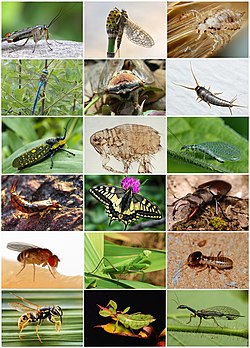
Back ثنائيات اللقمة Arabic ثنائيات اللقمه ARZ Dicòndils Catalan Dicondylia German Dicondylia Basque دوکوژگان Persian Dicondylia French Dicondylia Galician Dicondylia ID Dicondylia Polish
| Dicondylia | |
|---|---|
 | |
| Diversity of dicondylians from different orders. | |
| Scientific classification | |
| Domain: | Eukaryota |
| Kingdom: | Animalia |
| Phylum: | Arthropoda |
| Subphylum: | Hexapoda |
| Class: | Insecta |
| (unranked): | Dicondylia Hennig, 1953 |
| Subgroups | |
| |
Dicondylia is a taxonomic group (taxon) that includes all insects except the jumping bristletails (Archaeognatha). Dicondylia species have a mandible attached with two hinges to the head capsule (dicondyl), in contrast to a hypothetical ancestral mandible with a single ball joint (monocondyl); the members of Archaeognatha do in fact have dicondylic mandibles, though they are not identical to the structure seen in "true" dicondylic insects.[2]
- ^ Engel, Michael S.; David A. Grimaldi (2004). "New light shed on the oldest insect". Nature. 427 (6975): 627–630. Bibcode:2004Natur.427..627E. doi:10.1038/nature02291. PMID 14961119.
- ^ Blanke, A.; Machida, R.; Szucsich, N.U.; Wilde, F.; Misof, B. (2015). "Mandibles with two joints evolved much earlier in the history of insects: dicondyly is a synapomorphy of bristletails, silverfish and winged insects". Systematic Entomology. 40 (2): 357–364. doi:10.1111/syen.12107.